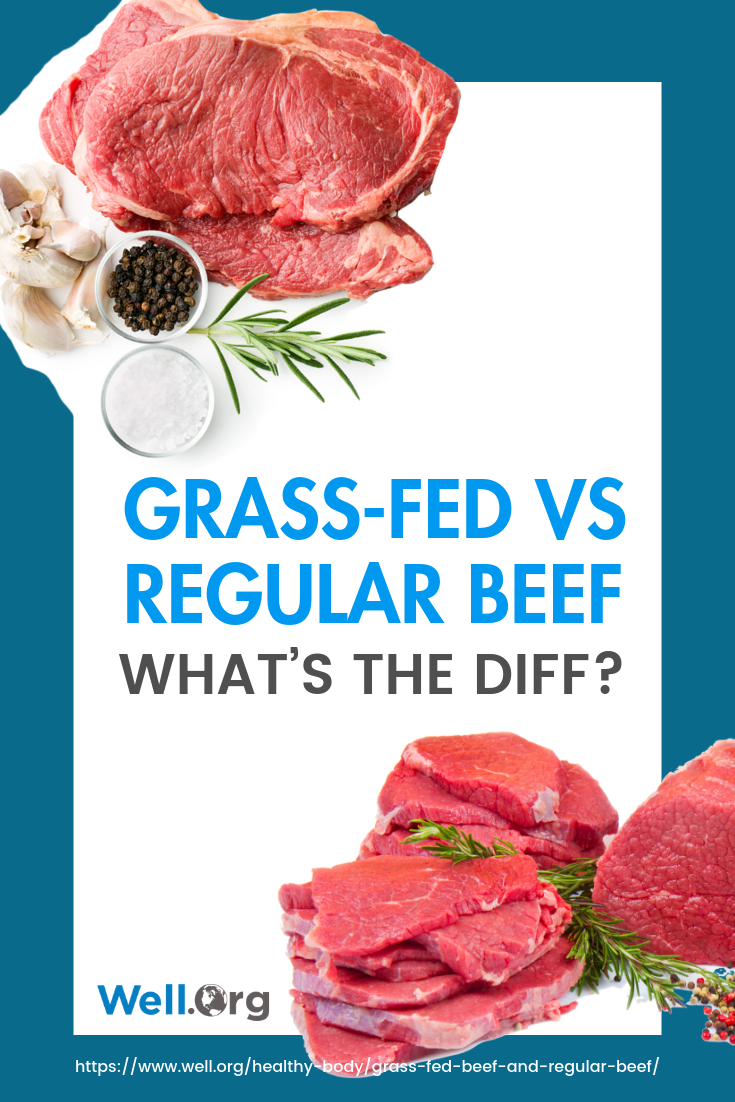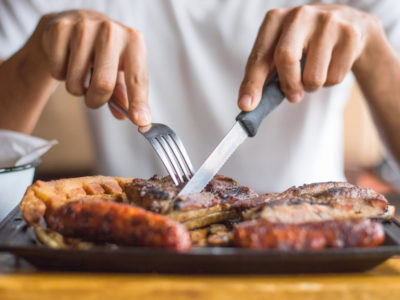Table of Contents[Hide][Show]
5 More Questions That Settle the Grass-Fed vs. Grain-Fed Comparison+−
- 1. Is There a Difference When It Comes to Grass-Fed vs. Organic Beef?
- 2. When It Comes to Grass-Fed Beef vs. Regular Beef, Which Has Better Taste?
- 3. Are Grass-Fed Cows Free from Disease?
- 4. Grass-Fed vs. Grain-Fed, Which Beef Has More Fat Content?
- 5. Which Cow Is Better for the Environment?
- Healthy Lessons From a Vegan
- Can Too Much Protein Cause Inflammation?
- Eat Less Meat Without Losing Protein With 5 Killer Protein Substitutes
When it comes to grass-fed versus grain-fed, which beef is better for your health? Learn the advantage of eating the meat of grass-fed cows here.
Grass-Fed vs Grain-Fed Beef: Which Is Better?
Health is all about choices, such as choosing grass-fed versus grain-fed.
To be clear, which one should you pick: grass-fed beef or regular beef? Which one is healthier?
Let’s break down the differences and benefits here!
But first, consider this for a second. The average American eats more than 60 pounds of beef every year.
This statistic tells us beef is a staple of the American diet and an integral part of our way of life. Now, this isn’t necessarily a bad thing!
If you are eating grass-fed beef, you’re probably getting a huge dose of perfectly-balanced, nutritious protein. Highly nutrient-dense foods satiate you faster, so you can’t overeat them easily.
Your body literally makes you put your fork down. You also won’t have to deal with ingesting chemicals if you opt to eat organic grass-fed beef.
Before going into that, let’s talk about the difference between grain-fed beef and grass-fed.
Grain-Fed Beef
- Do you know where your hamburger meat came from?
- Was the cow healthy or sick?
- Did the cow live a happy life?
The answers to these questions relate directly to your well-being as well as the planet’s.
Great news! This means you can immediately have a positive effect on both through one simple choice.
The first step to that wellness? Know the dangers related to that abundantly available, sold-on-every-corner, commercial beef.
The Grains
The first danger—grains.
Regular cows raised for their meat are given enormous amounts of corn and other grains during the second phase of their lives. Beef production is faster if farmers raise grain-fed cattle, but this may not be the healthiest option.
Grain-fed beef has high levels of saturated fat and omega-6 oils, which can promote heart disease.
The Hormones and Other Drugs
Most commercial beef calves become huge in just 14 months—from 80 to 1,200 pounds.
Livestock that gain this much weight over such a short period of time most likely receive supplements in addition to their food. That’s because farmers need to keep up with consumers’ beef products needs.
While some of this growth can be put down to protein supplements, any combination of the following hormones may be implanted or injected into them:
- Estradiol
- Progesterone
- Testosterone
- Zeranol
- Melengestrol acetate
- Trenbolone acetate
And we’re finding out our own consumption of estrogen from hormone-fed beef can increase the risk of cancer, premature puberty, and male infertility.
Now we can cue the vaccines and other medicines, which may include:
- A 4-way viral and 5-way leptospirosis vaccine and vibriosis protection cocktail
- A drug to prevent clostridial diseases which can be fatal to cattle
- Medicine to prevent calf scours
- Something that prevents and/or treats internal and external parasites
What is leptospirosis? This is a bacterial disease found in rodents, dogs, and other mammals. It is infectious to humans.
What is vibriosis? This is a venereal disease (obtained through sexual contact) common among cattle. It is a bacterial infection that causes infertility and spontaneous abortion in cattle.
Doesn’t it make you wonder what beef doesn’t contain residues of all these chemical and anti-parasitic substances taste like?
The Antibiotics
As if the hormone- and vaccine-injected beef weren’t sad enough, farmers are using around 28.9 million pounds of antibiotics in animal agriculture annually in the States.
In fact, around four times more antibiotics were used for animals than by humans in America in 2009. And these antibiotics aren’t primarily used to treat cow diseases or alleviate their suffering when they’re unwell.
Nope. They’re often used just in case as well as to fatten them up and make them grow more.
The crowded conditions cows are raised in also make them sick more often, so preventative measures probably seem even more critical. A sick cow costs money, of course.
So what does this routine antibiotic use in cows mean for you? Unfortunately, it can mean antibiotic resistance.
It also means you might be consuming a lot more than beef when you slice into that yummy steak and slide the fork into your mouth.
Related
Antibiotics, Their Side Effects, and How to Avoid Them
Learn about antibiotics side effects (from long and short-term use) and what probiotics to take while on antibiotics to help repair the damage they cause to your gut health.
The Irradiation
Some commercial beef is irradiated, which is another way of saying blasted with gamma rays produced by radioactive material or electricity to kill bacteria. They don’t know what effect this has on the body just yet.
What are gamma rays? These are the most active and energetic electromagnetic radiation, used in X-rays and in anti-cancer treatments.
Inhumane Conditions
Imagine you were allowed to roam free and eat all the natural food available around you for the first 70% of your life. Then, you were denied some of the most basic requirements of life for the rest: fresh air, space, and normal social interaction.
It’s like being taken good care of until your old age and then being cast out into the cold. That’s basically what grain-fed cows have to deal with. On some ranches, they are kept in tight cages their entire lives.
The Benefits of Grass-Fed Beef
Why is grass-fed beef better? Organic, grass-fed beef (such as Butcher Box’s beef) may:
- Contain twice as much omega-3
- Contain two or three times more conjugated linoleic acid (CLA), a potential cancer fighter and heart disease reducer
- Come from more environmentally-friendly, (22-35% more) profitable, and sustainable farms
- Contain significantly less toxic heavy metals and carcinogens
- Have less total fat and a healthier fatty acid composition
- Contain no antibiotics, vaccines, hormones, or other hazardous drugs
- Contains essential antioxidants, vitamins, and minerals including vitamin B12 and E, beta-carotene, zinc, selenium, choline, phosphorus, iron, and pantothenic acid
There are other benefits of grass-fed beef. You just have to be careful to ensure you’re really getting the meat from a naturally fed, humanely-treated cow.
How to Buy American Grass-Fed Beef
So where can you find this kind of beef without being tricked? To make sure you get organically raised and fed beef, you need to look for a local supplier.
Grass-fed animals can be hard to find. Start by looking for ranches that allow their cattle to graze in pastures filled with organic grass and plants.
Getting pre-cut meat from the grocery store may not be the best choice. Sadly, beef that is not grass-fed is often labeled as such.
You need 100% grass-fed, not 50%! Right?
It’s important to know where to buy grass-fed beef. The best way to ensure you are really eating 100% grass-fed beef and getting all the benefits is to go straight to a trustworthy source.
Butcher Box is one of those sources. Get your clean, hormone-free, healthy ribeye steak from them!

5 More Questions That Settle the Grass-Fed vs. Grain-Fed Comparison
To further help you decide between these two types of beef, here are some FAQs you should know.
1. Is There a Difference When It Comes to Grass-Fed vs. Organic Beef?
Much of the confusion with grass-fed versus grain-fed stems from the fact there are so many terms to understand. For example, people use words like “grass-fed” and “organic” interchangeably when they don’t mean the same thing.
With grass-fed vs. organic beef, it’s all about the type of animal feeding the cows receive or the source of their diet.
A grass-fed beef means the meat comes from cattle that graze pastures and eat grass. Organic beef means the cow didn’t receive any synthetic growth hormones, vaccines, and antibiotics.
Note, however, organic beef can still mean the cows are grain-fed with soy or corn, only the corn and grain are grown from organic land.
Meanwhile, grass-fed beef may eat grass from land previously burdened with chemical fertilizers. In turn, the meat is still not organic.
2. When It Comes to Grass-Fed Beef vs. Regular Beef, Which Has Better Taste?
Let’s face it, while it pays to eat healthily, we might as well enjoy the food we eat. With regard to grass-fed versus grain-fed, which of these two types of beef tastes better?
The choice is actually not unanimous. Some people like the taste or flavor of grain-fed beef because of its higher amount of fat and marbling, which is the flecks of fat in between the muscles.
The more marbling you see, the more the meat can tolerate varying degrees of heat. Fat also gives the meat more flavor, so it tends to be juicier.
There are also others who consider, say, grass-fed ground beef to be chewy and gamey, but it has its own distinct taste that makes it special over grain-fed beef.
In other words, grass-fed vs grain-fed beef taste depends on what the person prefers.
3. Are Grass-Fed Cows Free from Disease?
Cows are not immune to disease, but while some are treatable, others are fatal. Worse, they can affect human health.
One of these is mad cow disease. Also known as bovine spongiform encephalopathy (BSE), it is a disease caused by a protein called a prion.
Scientists aren’t sure how cows develop this, but one thing is clear: healthy cows can contract the disease usually due to the method of animal feeding.
It may be gross to think about, but when it broke out in Europe, the primary reason was living bovines dined on the dead, which meant they ate the prion.
Now, it may seem with the debate of grass-fed versus grain-fed, the cows that eat grass seem healthier and more immune from mad cow disease.
Note, however, that grass-fed cows can still end up eating other grains and food, especially when they’re nearing their slaughter date.
4. Grass-Fed vs. Grain-Fed, Which Beef Has More Fat Content?
As they say, you are what you eat. The same thing applies to cattle.
If one does a grass-fed beef nutrition comparison, especially when it comes to fat, you’ll find it is leaner than corn-fed or grain-fed beef. In other words, it contains less fat, which may partly explain its chewy texture.
Diving deeper, however, you learn they also differ in the quantity and type of fatty acid they provide. Take, for example, this analysis from the Texas A&M University researchers.
The team analyzed the fatty acid profiles of ground beef from grain-fed and grass-fed cattle. They learned omega-3 fatty acids in the form of alpha-linolenic acid were higher among those that fed in the pasture.
Omega-3 is a nutrient that may help reduce the risks of cardiovascular disease as it prevents chronic inflammation.
Meanwhile, oleic acid, which may help bring down cholesterol levels, was more notable in grain-fed beef. Perhaps what is more controversial is the amount of trans fat.
For many years, trans fat has received a bad rep because of its ability to increase the risks of metabolic diseases such as heart disease and hypertension.
This fat, however, comes from the hydrogenation of oils, the conversion of fats from unsaturated to saturated by introducing hydrogen.
The trans-fatty acid in meat is more naturally occurring, and it’s present in a mother’s milk. One study showed it may even be beneficial to one’s health when consumed in moderation.
5. Which Cow Is Better for the Environment?
The grass-fed beef vs. corn-fed beef debate far extends from their nutrition composition. It also touches on their contribution to climate change.
Studies showed cows do contribute to climate change through the production of the greenhouse gas called methane. Livestock creates it during the fermentation process in the intestines and excretes it when they burp or fart.
Some people assumed shifting to grass-fed beef helps reduce the carbon footprint or delay climate change. A study published in the Animal Frontiers disagreed as they can still produce methane and livestock production still uses a lot of resources.
If you want to save the environment, the best way is to reduce your consumption of meat. Even better, shift to a plant-based diet.
Eating a plant-based diet further improves your health as the food sources are lower in bad fats than grass-fed or grain-fed beef. With options such as Alkaline Greens, choosing this lifestyle is also more convenient.
Before you think about grilling steak for dinner, perhaps, this is the time to start considering whether you’re getting the right type of meat first. To eat healthily, always opt for grass-fed beef.
Apart from searching for grass-fed beef, part of the challenge is also sourcing for ranchers who only breed grass-fed cattle or grass-fed cows.
You have to be 100% sure the cows eat grass in a well-maintained pasture and they’re free of any chemicals or unnecessary medication.
If you are a beef lover, that’s exactly why you should take action towards switching to eating organic beef instead. Your body will thank you for it!
You May Also Like…
U
E
Editor’s Note: This post was originally published on June 9, 2017, and has been updated for quality and relevancy on September 18, 2019.





